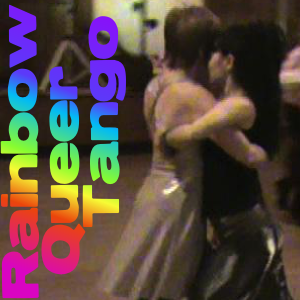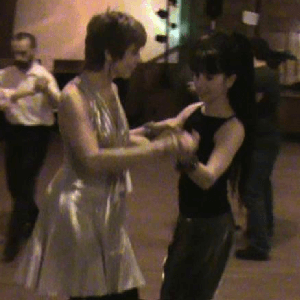QUEERING THE WORLD’S MOST ROMANTIC DANCE
GLBT people grasp the magic of Argentine Tango – in Buenos Aires, Berlin, San Francisco, New York, Stockholm, New York, Boston, Portland, Wellington, México City… and Sydney
info@rainbowtango.com
0478.397.203
September, 2011
Argentine Tango is danced every night, all over the world. It is an international language which enables strangers to experience connection, intimacy, self-expression, and a rush of ecstasy. They needn’t exchange names, or even speak. With the entry costs low, tango is an unusual space where people of all social classes mix without distinction. And the average tango milonga is an age-diverse environment; teenagers and masterful elders dance with each other. Elegant and sexy, tango is a full time stage of drag kings and queens. Dancers of all ages wear suits and hats, high heels and skirts slit to the thigh. But until recently, Argentine Tango has been all but closed to gays and lesbians. With women forbidden to lead the dance and men dancing together only for instruction, not socially, tango has been unwelcoming to GLBT people.
But tango, and Argentina, is changing. The first gay milonga was created in Buenos Aires in 2003, the same year the city legalized gay civil unions, and in 2009 same-sex marriages. Now, more than 20% of the tourists are gay. In 2007 the government co-sponsored the first International Queer Tango Festival, now an annual event. Lively queer tango communities and festivals have also been built in Hamburg and Stockholm. In 2009 the OutGames in Copenhagen included a Queer Tango festival and San Francisco hosted the first US Queer Tango festival. GLBT tango classes are now offered in major cities around the world.
There is now a global Queer Argentine Tango community
Founder of Queer Tango Boston and Queer Tango Wellington (NZ), Vio Saraza, notes that “We are never the first. Someone started a Queer Tango group in Boston back in 1998. In Hamburg, the first tango in the city happened in a gay bar.” There was a lively Queer Tango scene in Sydney a few years go, but it seems to have waned.
In Vio’s Rainbow Tango classes, all students learn to lead and follow. They may keep this up, or they may eventually choose a role they prefer. But it won’t be based on their gender. “Sometimes guys who hated leading at first now prefer it. And vice versa.” But they point out that “We have to queer the codes of tango, too. Because leaders can’t assume that every femme wants to follow.” She’s written a guide for their students on how to use the traditional “cabeceo”, the gift and receipt of a nod by which a dance is contracted. The cabeceo protects the ego of the dancers, who turn each other down discretely — by not making eye contact. “In tango, we take very good care of the ego. It’s a formal, elegant way to interact. But in that it’s also very kind.” Argentines often call tango their “therapy”.
Along with co-founder of Queer Tango Boston, Duro, writing under the joint name Dyv Saraza, Vio wrote a novel about tango which worked to help readers imagine a Queerer Tango. Published in 2009, Aleph Bravo Tango is loved by dancers straight and gay alike, who find it does an extraordinary job of conveying the emotional subtleties of this addictive experience.
Vio prefers a happy and playful approach to tango, well suited to the queer practice of swapping the lead during the dance. But like all Argentine tango, it’s really about connection and learning to listen to another person with your body. As the leader interprets the music (dancing to the rhythm or melody as they wish), the attentive follower is ready to go in any direction at every moment, so they are able to move as one, although every step is improvised. “We really want to work with people who don’t have dance in their lives yet. To tango is to take a walk in a tender embrace. We want walkers.”
Vio explains what tango has meant to her. “I’m a very words person. Tango has enabled me to find another way of appreciating and communicating with people.” She explains that the language of tango facilitates a sublime level of connection, doubly amazing in that it is a routine part of the dance. “You have this incredible experience with someone you may never see again. Or perhaps with someone you dance with every week – but you only know their ’sobre nombre’ (over name). And for a couple it gives you a new way to connect with each other – especially when words aren’t working.” Duro, co-founder of Queer Tango Boston, a longtime rave|goth clubkid, calls tango “my golf. It’s something exciting I can do until I’m very old.”
Preparing to move away from Boston, Duro and Vio helped their students create a community organization which continues to welcome new GLBT dancers with weekly classes and a social “practica”. After leaving the US, committed to creating more space for Queer “Tangueros”, Vio went on to found a second community in Wellington NZ, which, likewise, now runs its own events. “I promise my students that everywhere I go, I will keep creating space for gay people to enjoy this dance.” Beyond confirming experts’ views that partner dancing is emotionally uplifting, Vio is interested in Tango’s contribution to self-confidence. “It’s the first time I really felt totally femme, although I have a femme appearance. And at the same time, leading Tango has helped me embody my butch. Tango is such an extreme gender performance! As a leader, I walk and move and touch another person in this really gracious, tender, masculine way. As a follower, I can move in that little girl fantasy of femininity. It feels like being the ballerina on top of the jewelery box.”
Who will enjoy tango?
People who are sick of the bar scene, bored with small talk, looking for a profound way to connect with people, or interesting in using their body in new ways.












